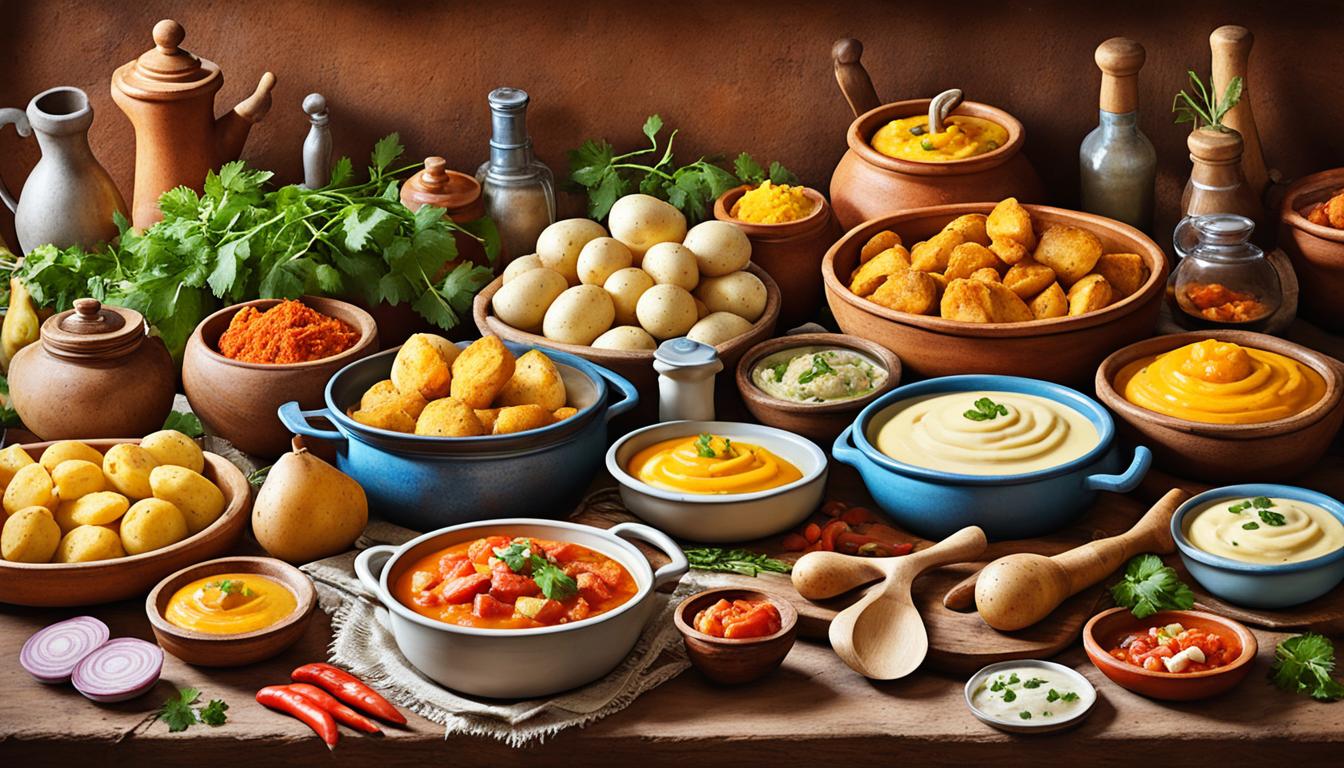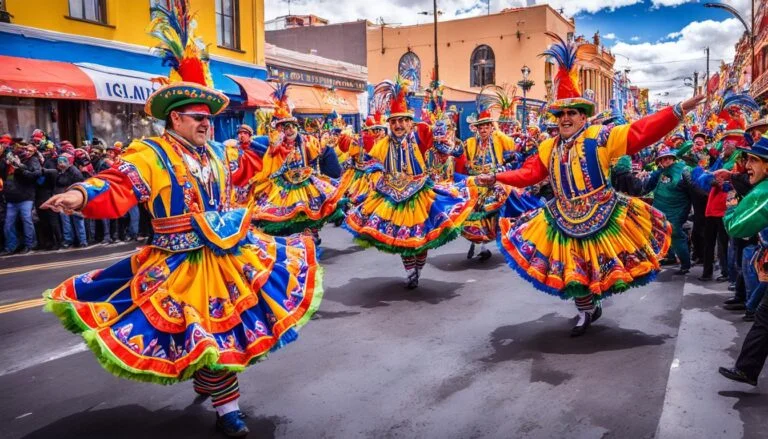Taste of Bolivia: A Culinary Journey Through Traditional Flavors
Have you ever thought about the amazing foods hidden in South America? Get ready for a delicious trip through Bolivian cuisine. It’s a mix of amazing flavors showing the country’s deep culture. All the way from La Paz‘s busy streets to the calm Lake Titicaca, you’ll find dishes that are a must-eat. They’ll definitely make you hungry for more.
Why does Bolivia’s food culture catch everyone’s attention? Let’s dive deep and find out what makes it special. It’s a rich blend of local ingredients and influences from Spain, Africa, and the Andes.
Ready to explore Bolivian street food, learn about traditional dishes, and even take some cooking classes? You’re about to start a journey celebrating Bolivia’s rich past and flavors. Bolivian cuisine is truly a gift of many tastes.
Key Takeaways
- Bolivian cuisine reflects a vibrant fusion of indigenous, Spanish, African, and Andean culinary influences.
- Explore the must-try traditional Bolivian dishes that showcase the country’s rich food culture.
- Discover the diversity of Bolivian street food and the unique flavors of regional specialties.
- Immerse yourself in the world of Bolivian cooking classes to learn the secrets behind traditional Bolivian dishes.
- Uncover the hidden gems of Bolivian cuisine and embark on a culinary journey that celebrates the country’s rich heritage.
Iconic Bolivian Dishes: A Flavor Odyssey
Bolivia’s diverse food scene is like a colorful storybook. Each area tells its own tale through food. You can find must-try dishes like the rich salteñas, the filling silpancho, and the spicy pique a lo macho.
Salteñas: A Savory Street Food Staple
Salteñas are a top pick among Bolivian street foods. They’re pastry-like, filled with seasoned meat, potatoes, and veggies. Bolivians love to grab one for breakfast or a quick bite. Finding them hot and fresh on La Paz’s streets is a treat. What sets a salteña apart is its crust, which should be crisp and gold, holding all the goodness inside.
Silpancho: A Hearty Cochabamba Classic
The Cochabamba area is known for silpancho. This meal is both comforting and complex. It starts with a thin, crispy piece of Bolivian beef or llama meat. This is laid on rice and crowned with fried eggs. Sides of potatoes and fresh salsa make every bite a joy. Its mix of textures and colors makes silpancho a true taste adventure.
Pique a lo Macho: Sizzling Spice and Flavor
Those who love bold flavors shouldn’t miss out on pique a lo macho. It’s a spicy dish with meat, onions, tomatoes, and rocoto peppers. This dish is served with fries and topped with eggs and spicy sauce. It’s a meal for the daring, offering a combination of heat and flavor.
The Bolivian Food Guide: Exploring Regional Specialties

Bolivia has a rich and varied food scene. Each region has its own specialties. In La Paz, you’ll find a mix of indigenous, Spanish, and Andean flavors. This creates a lively food culture.
Here, you can try famous street foods like salteñas. Or enjoy comforting dishes such as silpancho. La Paz is a great starting point to explore Bolivian cuisine.
Sucre: Colonial Flavors and Ancient Traditions
Sucre is known for its well-preserved colonial buildings. Its food proudly shows off the mix of indigenous and Spanish influences. Try chuño, a dish from the Andean highlands, or api con pastel, which is corn pudding with crispy pastries.
Spending time in Sucre means enjoying meals that bridge the past with today. The city’s dishes are a taste of Bolivian food history.
Santa Cruz: A Taste of the Tropics
In Santa Cruz, visitors get a tropical food adventure. The city’s food reflects the lush rainforest around it. Expect to see yuca, plantains, and lots of tropical fruits used in cooking.
Try dishes like salta de quinoa, a stew with the nutrition-packed quinoa. Tucumanas are deep-fried empanadas filled with local treats. They really show off the Bolivian Amazon‘s food traditions.
Bolivian Ingredients: Building Blocks of Flavor

In Bolivian cooking, special ingredients play a big role. These items have been at the center of dishes for many years. Quinoa is one of these, known as an Andean superfood. It’s a key part of meals like quinoa soup and salad. This food is very versatile and packed with good nutrients. The process of growing and cooking quinoa shows the respect for traditions in the Andes. This highlights Bolivia’s strong link to its farming past.
Aji Peppers: A Fiery Flair
Bolivian food is famous for its strong, exciting flavors. The aji pepper is at the heart of this. These chili peppers come in many types, from very hot to mild. They’re used in lots of Bolivian recipes to add heat and flavor. For example, sauces or side dishes. It shows how Bolivians enjoy food that’s full of flavor and adventure.
Potatoes: A Diverse and Beloved Staple
Potatoes are very important in Bolivian food, connecting deeply with its Andean roots. This versatile, well-loved food is in many Bolivian meals. You’ll find them in dishes like silpancho and the traditional chuño. Potatoes are key to Bolivian cooking, showing how creative they are with local foods.
Conclusion: Embracing Bolivia’s Culinary Heritage
Discovering Bolivian cuisine is like diving into a treasure trove. It shows off the varied tastes and traditions of the food culture. You’ll find delights like salteñas and silpancho, which are packed with flavor. Then there’s pique a lo macho, a spicy favorite, and api con pastel that warms the heart.
Every dish shares a piece of Bolivia’s story, blending tradition with innovation. This mix brings out the vibrant tastes of the Andes. Whether you’re in a busy La Paz market, enjoying Sucre’s colonial flavors, or lost in Santa Cruz’s tropical treats, you’re in for an adventure. It celebrates Bolivia’s cultural heritage in every bite.
So, when you try Bolivian foods, you’re not just eating. You’re delving into a world of flavor and history. This journey opens your eyes to Bolivia’s customs and creates memories that stick with you. The experience deepens your love for the diverse Bolivian cuisine.
It’s more than just food. Bolivia’s culinary scene shows off its strength, creativity, and commitment to tradition. By choosing Bolivian food tourism, you get to explore this amazing South American spot. You taste dishes crafted for centuries, feeling a part of Bolivia’s rich cultural tapestry.







